Exploring the Benefits of Small Harvesting Machines
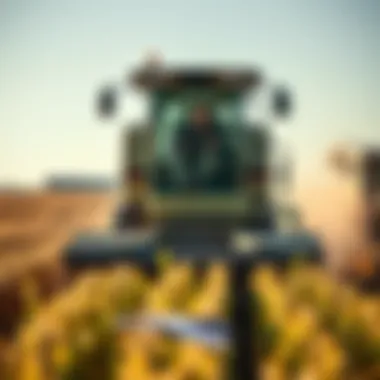
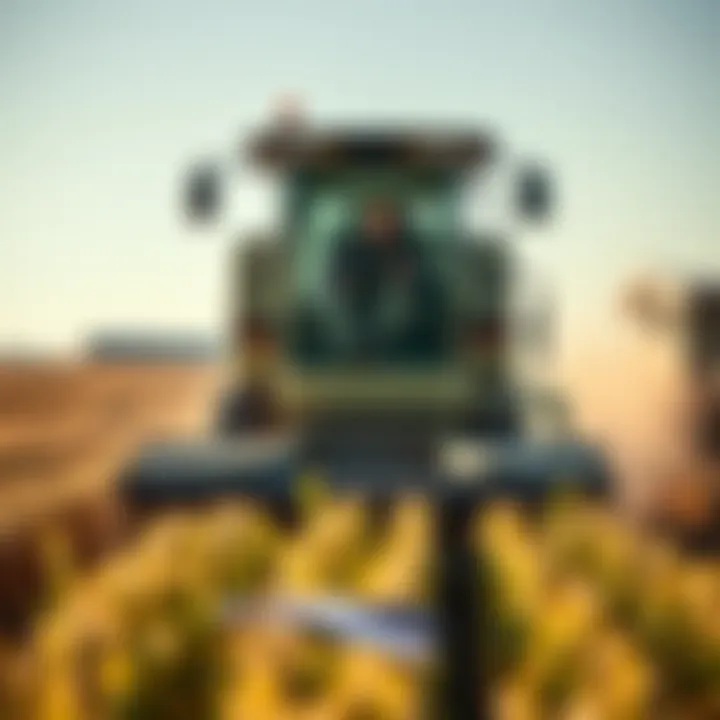
Intro
Small harvesting machines have become crucial tools in the agricultural landscape, catering to both amateur gardeners and seasoned farmers. These machines, designed to be compact and efficient, deliver ease of use without sacrificing power. In a world where every square foot counts, particularly in urban and small-scale farming, understanding the design and application of these machines is more important than ever.
As we delve deeper into the functionalities and advantages offered by small harvesting machines, we uncover how they align with modern agricultural practices and the shift toward sustainability. This article aims to provide a thorough understanding of these machines, tapping into their capabilities to meet specific agricultural needs while mitigating environmental impact.
Key Insights
Overview of the Topic
Small harvesting machines come in various shapes and sizes, from motorized sickles to compact combines. Their versatility allows them to tackle diverse crops, whether it is tomatoes, beans, or grains. A defining characteristic of these machines is their growing incorporation of advanced technology, elevating both the speed and accuracy of harvesting processes. This evolution has made them indispensable in many agricultural settings.
Their relevance is increasingly acknowledged, not merely as labor-saving devices but as essential components of modern agricultural practices. With the right machine at your disposal, achieving higher yields with less effort becomes a tangible reality.
Importance in Agriculture/Horticulture/Agronomy
The importance of small harvesting machines extends beyond mere convenience. They represent a shift in agricultural methodology aimed at increased efficiency and sustainability. By adopting technology, farmers can respond rapidly to changing conditions, reducing waste and improving productivity.
- Efficiency: We can’t ignore how these machines have refined harvesting practices. They minimize the time taken to collect crops, allowing farmers to focus on other essential tasks.
- Cost Effectiveness: Smaller machinery often comes at a lower price point and can be more easily maintained, making themaccessible for smallholders and hobbyists alike.
Moreover, these machines also ease the physical burden often placed on farmers and their laborers, for they simplify processes that once required significant manual labor.
"Small harvesting machines enable an effective pathway to bridge traditional farming practices with modern technology."
Sustainable Practices
Eco-Friendly Techniques
With global awareness about climate change on the rise, sustainable farming practices have gained traction. Small harvesting machines, when designed with eco-friendliness in mind, help to address some of these concerns. Many models are now energy-efficient or powered by renewable energy sources, making them a great option for environmentally conscious farmers.
Practices like precision agriculture, where small machines facilitate targeted harvesting, prevent overuse of resources and enhance crop yield. By reducing chemical inputs through more effective harvesting policies, small machines contribute to sustainable agriculture that respects soil health and ecosystem integrity.
Case Studies on Sustainability
Consider the use of small harvesters in community-supported agriculture (CSA) programs. These operations rely heavily on small machines to efficiently gather produce, which helps reduce food waste as farmers collect crops when they are at optimal ripeness. This proactive approach to harvesting supports local economies while nurturing natural resources.
Tools & Resources
Essential Equipment and Technologies
The selection of small harvesting machines is vast. Farmers looking to employ these tools should consider their specific needs and the crops they intend to harvest. Some notable examples include:
- Bcs Walk-Behind Tractor: This versatile machine can perform multiple tasks, from tilling to harvesting.
- Husqvarna Automower: A robotic mower that can also assist in maintaining smaller farming plots.
These machines are designed for various environments, catering effectively to both flat terrains and sloped areas.
Recommended Books and Readings
To deepen your understanding, consider the following resources:
- The New Organic Grower by Eliot Coleman - A practical guide for those transitioning to organic practices, examining various tools including small harvesters.
- Farmers of 40 Centuries by F.H. King - This text details sustainable agricultural techniques from around the world, linking them to equipment used in modern farming.
By integrating the knowledge gained from these readings, farmers can better utilize small harvesting machines in ways that align with their operational goals and principles.
Prelims to Small Harvesting Machines
The realm of small harvesting machines holds significant importance in the world of agriculture, as these tools bridge the gap between traditional farming methods and modern technological advancements. Understanding this category of equipment is vital for farmers, both seasoned and newcomers, who seek to enhance their productivity and efficiency. Furthermore, the variety in design and functionality of these machines allows for tailored solutions that meet the specific requirements of different crops and farm sizes.
With the burgeoning global population and the increasing demand for food, optimizing harvest processes becomes crucial. Small harvesting machines not only streamline the process but also play a critical role in ensuring sustainability in agricultural practices. These tools can help reduce wastage and improve yield quality, while also lessening physical labor demands on farmers.
In this exploration, we will delve into the definitions, historical context, various types, and benefits of these machines. Through a comprehensive understanding, agricultural professionals and enthusiasts alike will be better equipped to make informed decisions regarding their integration into farming operations.
Definition and Overview
Small harvesting machines can be described simply as tools designed to assist in the collection of crops from the field. They are typically smaller in size compared to their larger counterparts and are well-suited for small to medium-sized farm operations. These machines vary greatly; some are manually operated while others are automated, reflecting advancements in agricultural technology.
This diversity allows for improved efficiency in harvesting various crops, from grains to vegetables, adapting to different terrain and farming conditions. Understanding the specific applications and features of these machines enables farmers to select the right tool for their needs, enhancing their operations.
Historical Context
Looking back, the evolution of harvesting equipment spans centuries. Initially, crops were harvested manually using simple tools like sickles and scythes. These methods, while effective, were labor-intensive and time-consuming. As technology progressed, mechanized harvesting began gaining traction in the late 19th century, with the introduction of machines capable of cutting and gathering crops at a much faster rate. These early harvesters laid the groundwork for the development of small harvesting machines.
The post-World War II era brought significant innovations, including the rise of tractors and attachments that supported various types of harvesting. As agriculture became more commercialized, the demand for efficient equipment increased, leading to advancements in engineering and design. Today, we witness a plethora of small harvesting machines, equipped with features that enhance usability, such as adjustments for different crop types and improved fuel efficiency. This historical journey underlines the importance of adaptability and evolution in farming technology to meet growing global food demands.
Types of Small Harvesting Machines
Understanding the variety of small harvesting machines offers great insight into their importance within modern agriculture. These machines are crucial for tailored solutions to specific farming tasks. Farmers, whether seasoned or novices, face diverse challenges when it comes to harvesting crops efficiently. Hence, recognizing the differences between various types helps in choosing the right tools for the job—ultimately boosting productivity and sustainability in their operations.
Manual vs. Automated Machines
When it comes to harvesting, the choice between manual labor and automation is significant. Manual machines, often simpler and less costly to acquire, rely heavily on human operators. Tools like sickles or hand-held harvesters ask for physical effort.
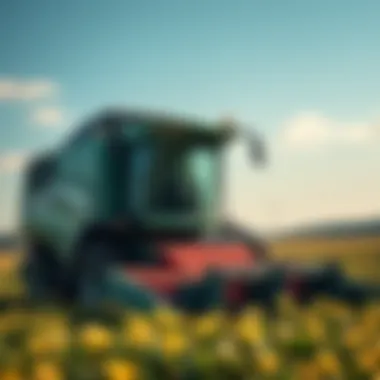
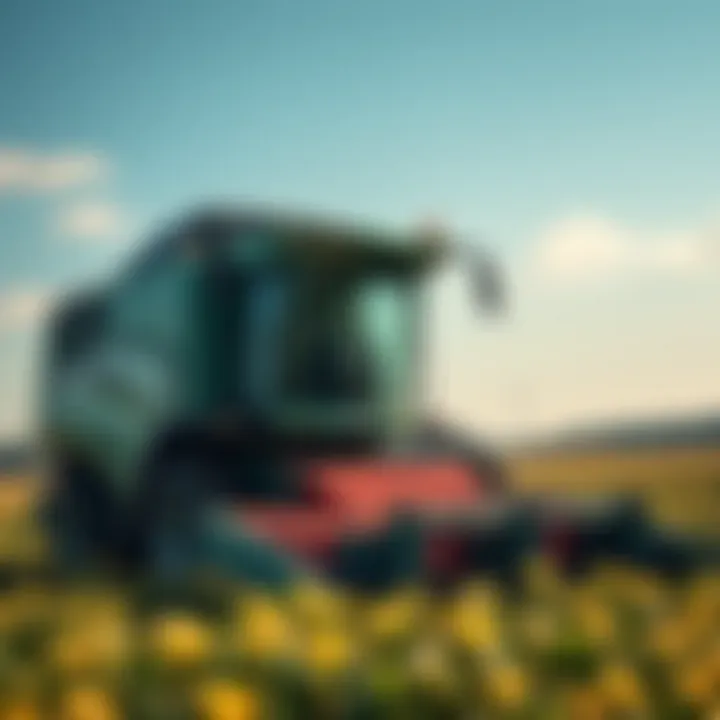
On the other hand, automated machines bring a new level of efficiency. For instance, consider the small self-propelled harvesters. They can drastically cut down on time and effort. People often think that automated machines are only for large farms, but advancements have made them accessible for smallholder farmers. The integration of simple controls allows even those with little experience to operate these machines effectively, leading to smoother harvests with less physical strain.
"A decision between manual and automated machines isn't just about cost; it's about the overall efficiency and labor management during harvest season."
Pros and Cons:
- Manual Machines:
- Automated Machines:
- Pros:
- Cons:
- Lower initial cost
- Simple design
- Higher physical demand
- Slower harvesting process
- Pros:
- Cons:
- Increased efficiency
- Less labor-intensive
- Higher upfront investment
- Requires maintenance and repairs
Tractors and Attachments
Tractors are the heart of many small farming operations, serving as a base for a myriad of attachments designed specifically for harvesting. The versatility of tractors allows farmers to quickly switch between different attachments like sickle bars, forage harvesters, and crop lifters. These attachments enhance the functionality of tractors, enabling tailored approaches based on crop type and terrain.
Consider, for example, a small tractor equipped with a front-mounted sickle bar attachment. This setup is particularly effective for tasks such as cutting hay or other grasses. Conversely, a rear-mounted forage harvester attachment might be the go-to for those in need of quick and thorough grass collection.
Utilizing tractors and their attachments not only saves time but also optimizes labor costs. With the right attachment, one can switch tasks as needed—transforming a simple tractor into a multifunctional powerhouse in just moments.
Dedicated Harvesters
Dedicated harvesters are designed for specific crops, taking specialized machinery into consideration. These machines eliminate the guesswork involved in harvesting, ensuring quick and efficient operation. For instance, there are small strawberry harvesters that can efficiently pick ripe fruit without damaging plants, helping to maintain the quality of the produce.
These specialized machines come with features tailored to the cultivation practices of particular crops. A case in point would be the potato harvester that gently separates the tubers from the soil without bruising them, thus preserving market value. When farmers invest in dedicated harvesters, they're ultimately investing in precision—all of which translates to higher yields and better returns.
In summary, having a firm grasp on the types of small harvesting machines can really empower the way farmers approach their work. Each option—be it manual, automated, tractor-and-attachment combos, or specialized harvesters—offers unique advantages. Making an informed choice ensures farmers can tackle their specific challenges effectively while enhancing sustainability and productivity in their agricultural pursuits.
Functionality of Small Harvesting Machines
The functionality of small harvesting machines plays a critical role in modern agriculture, driving efficiency and effectiveness in crop management. These machines are not just mere tools; they embody the convergence of engineering, technology, and agricultural knowledge. When farmers consider adopting small harvesting machinery, they must understand how these machines operate, their core components, and what makes them indispensable in the field. The right functionality can lead to significant improvements in yield and productivity, offering farmers a competitive edge.
Key Components and Mechanisms
Small harvesting machines are equipped with several key components that work in harmony to perform their tasks. Let's break it down:
- Harvesting Head: This is where the action happens. The harvesting head varies in design depending on what it is intended to cut, be it grains, vegetables, or fruits. This part often comes with adjustable settings to cater to different crops.
- Chassis: The frame of the machine, known as the chassis, provides the structural integrity and stability needed to traverse uneven terrains. Strong chassis can support heavier loads, which is crucial for larger harvesting tasks.
- Engines and Motors: Whether powered by gasoline, diesel, or electricity, the engine is the heartbeat of any machine. Innovations in engine technologies have led to improvements in fuel efficiency and power output, making machines quicker and more cost-effective to run.
- Control Systems: Modern machines feature advanced control systems that allow for easy maneuverability. Farmers can operate these machines with precision, positively impacting their speed and effectiveness in harvesting.
- Conveyor Systems: After harvesting, crops need to be transported for further processing. A conveyor system within the machine facilitates smooth transport and minimizes the loss of produce.
Each of these components contributes to the overall efficacy of small harvesting machines, ultimately enhancing their performance and reliability in the field.
Operating Principles
The operating principles of small harvesting machines center around certain core mechanisms that ensure they fulfill their tasks with minimal disruption.
- Cutting Mechanism: Most small harvesters utilize rotating blades or other cutting tools that slice through plants with ease. The design of these tools can vary. For instance, some use rotating cylinders with knives, while others might employ sickles. Each design has its advantages based on crop type and terrain.
- Collection and Transport: Once crops are cut, the collection system comes into play, utilizing augers or belts to gather and transport the produce into onboard containers. This automated process reduces manual labor considerably, as it enables bulk handling of harvested goods.
- Crop Handling System: Not only does this include the collection methods, but it also involves specialized mechanisms designed to minimize damage to delicate crops. For instance, softer fruits require gentle handling to avoid bruising, which can be critical in maintaining quality for market.
- Power Transmission: The transfer of power from the engine to various working parts is crucial. Gears, belts, and chains are engineered to ensure maximum efficiency, allowing machinery to operate smoothly under different load conditions.
Every farmer must understand how these systems work to ensure that they are using their machines effectively, maintaining them regularly to avoid downtimes. Proper knowledge of both the key components and operating principles of small harvesting machines is essential, enabling sustainable farming practices while maximizing output.
"When it comes to farming, understanding the machinery at your disposal can be the difference between a rich harvest and a bare field."
Benefits of Small Harvesting Machines
Small harvesting machines are essential in modern agriculture. They play a pivotal role in enhancing various aspects of farming practices. From small-scale family farms to larger commercial operations, these machines deliver significant benefits that are hard to overlook. Understanding these advantages helps farmers and agricultural enthusiasts make well-informed decisions about their operations.
Increased Efficiency and Productivity
One of the most compelling reasons to invest in small harvesting machines is the boost in efficiency and productivity they bring to the table. Thanks to their design and engineering, these machines accomplish more in a shorter period compared to manual labor. Tasks that once took hours can now be completed in a fraction of the time, allowing farmers to allocate their time and resources more effectively.
For example, consider a farmer who grows cabbages. With a manual approach, harvesting could require a full day of work for a handful of workers. However, using a small tractor-mounted harvester, the same task might take just a few hours for one person. This shift allows the farmer to expand into other activities, such as preparation for the next planting season or marketing the crop, ensuring all aspects of the business are addressed promptly.
Cost-Effectiveness in Farming
Small harvesting machines can also lead to notable savings over time. At first glance, the initial investment might seem daunting, especially for those managing tight budgets. However, the long-term gains often outweigh the costs. These machines can drastically reduce labor expenses. When fewer workers are needed for time-intensive tasks, savings pile up quickly.
Moreover, the precision offered by machines minimizes wastage, ensuring nearly every part of the crop is utilized. For instance, a machine that accurately cuts only the ripe strawberries not only improves the quality of the yield but also addresses post-harvest losses — a critical factor for profitability.
In some cases, farmers might even find themselves eligible for grants or financial assistance aimed at promoting efficiency in agriculture, thus lessening the burden of initial investments further.
Reduced Labor Intensity
Another significant benefit provided by small harvesting machines is the reduction of labor intensity. Farming has always been labor-intensive. Encounters with back-breaking work and long hours in the field are common. This can lead to fatigue, decreased morale, and even physical injuries over time.
With the introduction of small harvesting machines, farmers can tackle this challenge head-on. By incorporating technology, the physical strain associated with harvesting can be significantly lessened. Farmers using mechanized equipment still require some labor, yet they can focus on supervising operations rather than participating in the grueling tasks themselves.
For example, instead of a farmer bending down for hours to pick beans, they can operate a small machine that gently does the work while they oversee its functions. This way, they maintain productivity without sacrificing their health, ultimately contributing to a more sustainable practice in agriculture.


Investing in small harvesting machines may initially seem costly, but the potential improvements in efficiency, savings, and labor dynamics often pay off many times over.
Technological Advancements in Small Harvesting Machines
In the world of agriculture, keeping up with the times is paramount. Technological advancements in small harvesting machines are not just a trend; they represent a revolution in how we approach farming today. Integrating new technology into these machines enhances their efficiency, adaptability, and overall effectiveness in meeting the demands of modern agriculture.
With every new piece of technology, farmers have the opportunity to improve yields and reduce costs while operating in a more environmentally sustainable manner. Such innovations are tailored to optimize the harvesting process, ensuring that each machine functions seamlessly within its intended environment.
Integration of Precision Agriculture
Precision agriculture refers to the practice of using technology to monitor and manage field variability in crops. In the context of small harvesting machines, this integration means employing GPS, sensors, and data analytics to target areas of the field that may need more attention. A farmer utilizing a small harvester outfitted with precision technology can collect real-time data about crop health and soil conditions. This data helps in determining the best time to harvest, reducing waste and ensuring optimal quality of the yield.
Furthermore, tools like soil moisture sensors and crop health indicators can lead to smarter decision-making. Rather than relying on a one-size-fits-all approach, farmers can fine-tune their methods, applying precise amounts of water, fertilizers, and pesticides only where necessary. This kind of technology not only increases economic efficiencies but also aligns with the goal of sustainable farming by minimizing resource waste.
Smart Technologies and IoT
Smart technologies and the Internet of Things (IoT) play an increasingly critical role in the functionality of modern small harvesting machines. Incorporating IoT devices allows machines to communicate with each other, as well as with the farmer's management systems. For example, consider a scenario where a farmer’s harvesting machine can alert them if it's detected an issue, like a malfunction or an unexpected drop in performance. This immediate feedback loop saves both time and potential loss of crops.
The combination of smart technology and thorough data analysis can empower farmers to keep track of their machinery's performance, predict maintenance needs, and even monitor the harvesting process from a distance.
"Smart farming is no longer a concept confined to projections—it's a present-day reality that shapes how we cultivate our lands and tend to our crops."
Lastly, these advancements may lead to the integration of autonomous features in small harvesting machines. Self-driving technology and machine learning could soon enhance precision and reduce operator error, creating a more efficient working environment on the farm.
In essence, the advancements in technology not only position small harvesting machines at the forefront of agricultural innovation but also ensure that they meet the evolving expectations of farmers while promoting responsible farming practices. The future is not just about bigger machines, but smarter, more integrated systems that work in harmony with nature and technology alike.
Economic Impact of Small Harvesting Machines
Understanding the economic impact of small harvesting machines is crucial for both aspiring and veteran agriculturalists. These machines not only facilitate efficiency in farming but they also have wider implications on local economies and the overall agricultural market. By examining their influence on local economies and cost-saving potentials, we can appreciate their role in transforming agricultural practices.
Impact on Local Economies
Small harvesting machines can be considered as the unsung heroes of local agricultural economies. They bring about numerous benefits that ripple through various sectors. When farmers adopt these machines, they often see a boost in their productivity, allowing them to grow more and sell more. This increased agricultural output can encourage local businesses, such as seed suppliers and equipment repair shops.
- Job Creation: Interestingly, automating harvesting processes doesn’t just mean fewer jobs; it can create specialized positions. Workers may transition into roles that manage, maintain, or operate these machines, thus enhancing skill levels in the workforce.
- Local Investments: As farmers invest in these small machines, there tends to be a corresponding rise in investment in local supply chains. Farmers might also spend more locally on fuel, maintenance, and parts, bolstering the economic ecosystem.
- Market Stability: Small harvesting machines enable farmers to respond quickly to market demands. This versatility can protect local economies from the swings in crop prices, as farmers can adapt their production strategies based on current market needs.
In short, when looking at how small harvesting machines influence local economies, the effect goes beyond the field. It can create a more sustainable economic environment for everyone involved.
Cost-Saving Potential
The cost-saving potential of small harvesting machines cannot be overstated. Farmers no longer rely solely on labor-intensive methods that often incur hidden costs. The shift to mechanized harvesting means that financial resources can be allocated more efficiently.
- Labor Costs: First and foremost, the most significant savings can be observed in labor costs. Manual harvesting can require a considerable number of hands, often coming with hiring challenges and additional costs like benefits and overtime. With small machines, fewer workers are needed, and the productivity increase often compensates for the initial investment.
- Time Efficiency: Furthermore, these machines can significantly reduce the time taken to harvest crops. Reduced harvesting time translates into more time available to look after other farming activities or even diversify crop production. Think of it as getting more bang for your buck.
- Long-Term Investment: While the initial purchase may seem daunting, many farmers find that small harvesting machines pay for themselves over time through reduced operational costs and increased yields. This long-term perspective is crucial, especially in today’s economy, where every penny saved counts.
"Investing in small harvesting machines may seem like a hefty upfront cost, but look closer. The long-term savings and efficiency gains could turn the tide in your favor."
Environmental Considerations
In the conversation surrounding farming and agriculture, the topic of environmental considerations gains ever more importance. Small harvesting machines, while designed primarily to enhance productivity and efficiency, also have significant implications for the environment. Understanding these impacts is crucial for those invested in both farming and sustainability.
Sustainable Practices and Mitigation
With the rise of global awareness regarding climate change and sustainability, there’s been a shift towards practices that reduce environmental harm. Small harvesting machines can play a pivotal role in this. For instance, these machines often mean less reliance on manual labor, which can help minimize soil disturbance. When soil is disturbed less frequently, it maintains its structure and biodiversity, which is key for healthy crops.
Using these compact machines can also lead to more precise application of fertilizers and pesticides. Many of today’s small harvesting machines are equipped with advanced technology that allows farmers to minimize chemical use, applying them only where they are truly necessary. This precision is not just a boon for crop health; it's also an environmental win. Less chemical runoff means cleaner water sources and reduced harm to non-target wildlife.
Furthermore, many manufacturers are producing machines that meet sustainable practices; for instance, electric harvesting tools are becoming more popular. These machines significantly cut down on fossil fuel consumption, reducing greenhouse gas emissions.
- Benefits of adopting sustainable machinery:
- Reduces soil degradation
- Minimizes use of harmful chemicals
- Lower greenhouse gas emissions
Overall, embracing sustainable practices in small harvesting machines directly contributes to mitigating environmental impact while promoting a healthier farm system.
Noise and Emission Standards
The operation of small harvesting machines inevitably generates noise and emissions. However, as technology advances, so does the regulation and innovation aimed at reducing these drawbacks. Many regions have established strict noise and emission standards to protect communities and ecosystems.
For instance, machines are now built to produce less noise pollution. This is particularly advantageous for farmers operating in densely populated areas, where noise can disrupt both human and animal life. It is not just about avoiding complaints; quieter machines also ensure that wildlife is less disturbed, fostering a healthier local ecology.
Emissions, particularly particulate matter and carbon emissions, are another area of focus. New standards require manufacturers to create machines that are cleaner and more efficient. This is reflected in the integration of cleaner engines and hybrid technologies in some models, which reduces the carbon footprint significantly.
- Key points regarding noise and emission standards:
- Compliance with local regulations varies by region.
- Innovations in machine design contribute to both reduced noise and emissions.
- Enhanced technology leads to lower operational costs in the long run.
By maintaining conscientious practices in the agricultural sector, we're not only protecting our farms but also safeguarding our planet for future generations.
Ultimately, the environmental considerations surrounding small harvesting machines are multi-faceted, comprising sustainable practices that mitigate negative impacts and adherence to noise and emission standards. These practices are essential, not just for compliance, but for fostering a progressive, environmentally-conscious agricultural landscape.
Challenges and Limitations
Small harvesting machines are essential tools in modern agriculture, but like any technology, they come with their share of challenges and limitations that farmers must consider carefully. Understanding these factors is key for both seasoned agricultural professionals and those just starting out, as they guide choices about what equipment to purchase and how to integrate these machines into farming operations.
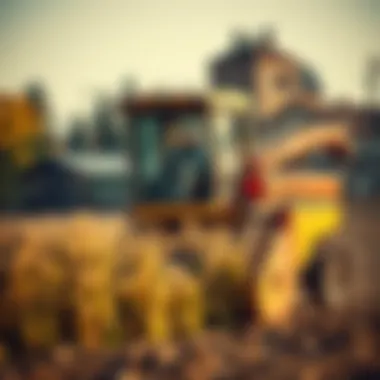
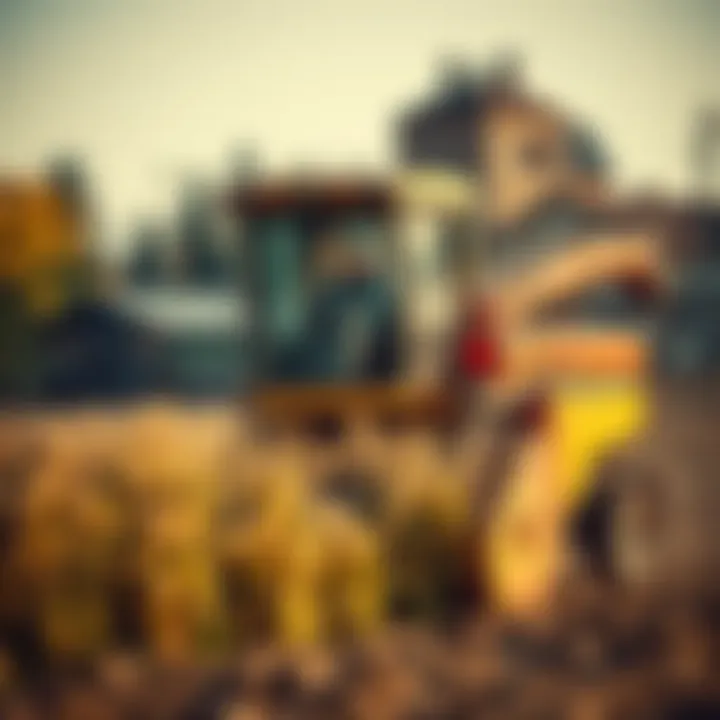
Maintenance Demands
One of the primary challenges associated with small harvesting machines is the regular maintenance they require. Unlike larger, more robust equipment that might withstand harsher conditions for longer, smaller machines can be quite sensitive to wear and tear. Components such as blades, belts, and engines need frequent checkups and replacements.
- Routine Inspections: Farmers must set aside time for routine inspections, which often means taking a day out of the busy growing season. This is especially vital for machinery like the John Deere 1023E sub-compact tractor, which, while compact, still requires diligent upkeep.
- Technical Knowledge: A significant portion of maintenance can often demand a level of technical know-how. If a farmer lacks familiarity with the machine’s functions, they risk expensive repairs that could have otherwise been avoided. Complicated machinery can turn what should be an easy fix into a time-consuming headache.
Properly maintaining small harvesting machines can also involve a range of costs, from spare parts to the occasional technician visit. According to a report from the American Society of Agricultural and Biological Engineers, farmers might want to set aside about 5-15% of their initial investment on maintenance annually to keep their machines in tip-top shape.
Initial Investment Costs
The initial investment in small harvesting machines can sometimes be daunting. While these machines are typically more affordable than larger counterparts, their costs can still swing widely based on capacity, brand, and specific features. Understanding the investment required can significantly affect a farmer's decision-making process.
Buying a compact harvester, such as a Kubota DC-91G, can set a farmer back a considerable sum. Factors to consider include:
- Brand Reputation: A machine from a well-known manufacturer might come with a higher price tag, but it often promises reliability and resale value.
- Features and Capabilities: Options that include advanced technologies often come at a premium. Investing in smart technologies may seem tempting but understanding long-term returns versus upfront prices is necessary.
- Financing Options: Several financial services provide options, but interest rates can affect the overall cost. Farmers must weigh the benefits before diving into financing arrangements.
Ultimately, the investment in small harvesting machines must align not only with a farmer's existing capabilities but also their long-term goals. This kind of planning enables better diversification in operations and underscores the importance of strategic investment when venturing into agricultural machinery.
In summary, while small harvesting machines offer numerous advantages, recognizing their maintenance demands and initial costs can help farmers create strategies that ensure maximum efficiency and profitability in their operations.
For more detailed information on maintenance and investment strategies, you can visit resources like Wikipedia on Agricultural Machinery or check agricultural forums on Reddit.
Understanding the challenges and limitations isn’t about being pessimistic; it’s about being realistic which greatly benefits proactive planning and decision-making.
Future Trends in Small Harvesting Machines
Understanding the future of small harvesting machines is essential for anyone involved in agriculture, whether you're a seasoned farmer or just starting with a vegetable patch. As the world of agriculture grows more complex, these machines are keeping pace by adapting to modern needs and integrating new technology. Future trends in this sector not only signify advancements in convenience and efficiency but also reflect a shift towards more sustainable practices.
Emerging Innovations
The realm of small harvesting machines is witnessing numerous innovations aimed at optimizing agricultural practices. For instance, advancements in robotics are revolutionizing how harvesting is done. Drones equipped with precision sensing technology can now survey crops, providing farmers with real-time data on crop health. This helps in early identification of issues that may require intervention.
In parallel, autonomous harvesting machines are making waves. These machines can traverse fields with minimal human input, reducing the need for labor while increasing efficiency. Equipped with GPS technology and advanced algorithms, they navigate fields with pinpoint accuracy, adjusting their operations based on real-time feedback.
Some small harvesters now include features that connect to smartphone apps, allowing farmers to monitor operations and machine performance from anywhere. This connectivity not only keeps track of the harvesting process but also aids in scheduling maintenance, ensuring machines are always in optimal working condition.
Moreover, electric-powered harvesting machines are gaining traction as the demand for greener farming solutions increases. These machines tend to be more environmentally friendly, with less noise and pollution than their diesel counterparts. Such shifts not only help in complying with stricter regulations related to emissions but also appeal to a growing consumer base that values sustainability.
Market Evolution
As the adoption of new technologies accelerates, the market for small harvesting machines is undergoing significant transformations. More manufacturers are entering the fray, spurred by the increasing demand for efficient and affordable solutions. This influx is promoting healthy competition, which, in turn, drives innovation and reduces prices.
In observation, the rise of e-commerce platforms is allowing farmers to access a wider array of products. Small harvesting machines that were once only available through specialized retailers can now be conveniently purchased online. This trend opens avenues for farmers to compare products, read reviews, and make informed decisions without stepping out of their farms.
Additionally, the concept of sharing economy is taking root in agricultural machinery. Farmers can rent small harvesting machines rather than purchase them, reducing financial burden and allowing them to use the latest technologies without the commitment of ownership. This trend is particularly beneficial for smallscale farmers, making it easier for them to adopt modern practices.
As the landscape continues to evolve, these future trends in small harvesting machines underscore the importance of adaptability in farming. The ability to embrace new technologies and trends not only enhances productivity but also promotes a sustainable approach to agriculture. For farmers looking to stay ahead, understanding and integrating these innovations will be key in the years to come.
Case Studies and Real-World Applications
Understanding how small harvesting machines perform in real-world settings is crucial for any farmer or agricultural enthusiast. Case studies offer insights into practical uses, showcasing both the successes and challenges that users face. These narratives not only highlight the versatility of such machines but also empower farmers to make better decisions tailored to their specific needs.
Success Stories from Farmers
Several farmers have adopted small harvesting machines that significantly changed their operations. For instance, take John, who runs a small strawberry farm in California. Before using a small mechanized harvester, he and his family would spend several long days hand-picking berries during harvest season. This process was not only labor-intensive but also time-consuming. Once he got his hands on a small, specialized strawberry harvester, the story changed. With quick adjustments tailored to the specific growth patterns of his bushes, John now manages to harvest up to five times the amount he could gather manually, all while cutting down labor costs by nearly 30%.
"It’s like switching from a horse to a car in terms of efficiency," he remarked during an interview.
Over in Oregon, Maria, who grows organic vegetables, had her fair share of issues with traditional harvesting methods. She faced not only back pain from bending but also slow harvest times which pushed her products to decline in freshness. After investing in a small multi-crop harvester, the difference was night and day. It had features designed for ergonomic handling, allowing her to gather and transport vegetables with ease. This transitioned her from local sales to supplying larger organic markets, effectively doubling her revenue within a single growing season.
Innovative Use of Technology
Technology is an ever-evolving force in agriculture, particularly with advancements in small harvesting machines. A notable example can be seen through the integration of GPS and precision agriculture techniques. These developments enable farmers to analyze field data and utilize machinery that responds dynamically to conditions like soil moisture and crop health.
For example, farming groups in the Midwest have started employing automated harvesters that not only increase yield but also maintain soil health through intelligent harvesting methods. The use of sensors allows these machines to determine when crops are at peak ripeness. Thus, farmers can optimize both the quality of their produce and their amount.
Furthermore, drones equipped with imaging technology provide invaluable assistance in pre-harvest phases. By determining the most efficient harvesting times through aerial data, these drones reduce waste and further enhance efficiency.
In summary, the stories from real-world applications and the innovative technologies being integrated into small harvesting machines show just how transformative these devices can be. From making life easier for farmers to significantly increasing productivity, the potential impact is profound. As we move toward the future, observing these developments will continue to illuminate the path for agricultural success.
Relevant Links
Precision Agriculture Overview
Success of Small Farms
Farm Technology Forum
USDA Resources on Agricultural Technology
Closure
The discussion surrounding small harvesting machines is vital, particularly within the agricultural sector, as it encapsulates the intersection of technology and farming practices. The importance of small harvesting machines boils down to their multifaceted roles in modern agriculture. Throughout this article, several key aspects emerge that highlight their relevance.
Summary of Key Points
- Understanding Varieties: The type of machine selected can significantly impact efficiency. Farmers can choose between manual and automated options, each serving specific needs.
- Operational Mechanisms: Knowledge of how these machines work—covering both key components and functionality—is crucial for maximizing their potential.
- Economic Benefits: The reduction in labor intensity, along with cost savings, can uplift local economies, demonstrating that small harvesting machines are not just tools but vital resources for sustainability.
- Technological Integration: The coupling of precision agriculture and smart technologies has enhanced their functionality, enabling farmers to manage their crops efficiently while being aware of ecological footprints.
- Environmental Considerations: The pressing need to adhere to noise and emission standards confirms the push towards sustainable agricultural practices.
- Understanding Challenges: Recognizing issues such as maintenance demands and initial investment costs is essential for informed decision-making.
The synthesis of these points doesn't merely present an overview but rather establishes a framework for understanding the advantages and trade-offs involved in employing small harvesting machines. Farmers and enthusiasts can find value here, navigating the complexities of modern agricultural practices while equipping themselves with the right tools to face the ongoing challenges of food production.
Future Outlook
The future of small harvesting machines is poised for significant advancements as technology continues to evolve. Innovations like autonomous operations and AI-driven analytics are on the horizon, promising to enhance the efficiency and utility of these machines further. Moreover, as the global focus on sustainability progresses, manufacturers will likely prioritize designs that minimize environmental disruption while maximizing output.
Additionally, there is a growing trend towards integrating user-friendly interfaces, making these machines more accessible to small-scale farmers and hobbyists alike. With education and support, future generations of farmers are expected to engage more comprehensively with these technologies, thus transforming agricultural practices on multiple fronts.







